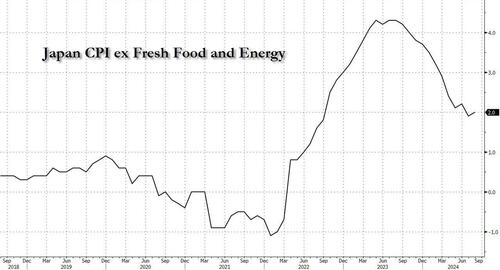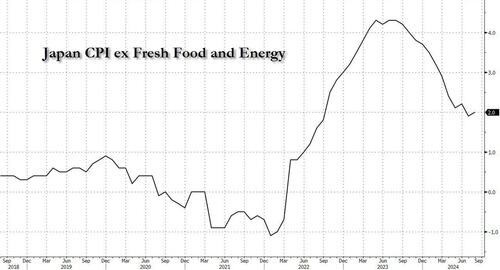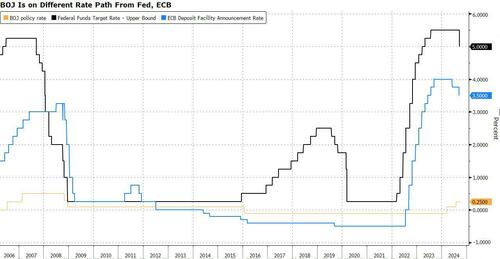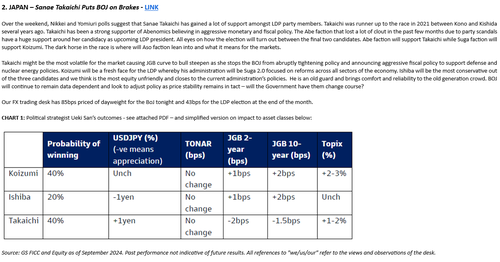Yen Plunges After Ueda Sees Little Urgency To Hike Rates As „Upside Risks To Inflation Are Easing”
After a week full of central bank fireworks, at least there were no surprises from the Bank of Japan last night, which was in focus as it kept policy unchanged, as expected However, after initially rising, the yen tumbled more than 1% after Governor Kazuo Ueda proved less hawkish than many traders expected, especially after his dramatic hawkish pivot back in July when he not only hike rates but signaled an aggressive tightening campaign, crushing the yen carry trade in the process and sparking the biggest Japanese stock market crash since Black Monday. Ueda signaled little urgency to hike rates, and said that upside risks to inflation are easing, pushing the likelihood of an October rate hike further to the sidelines Friday with a cautious message that pointed to ongoing concern over the market meltdown that followed July’s rate increase.
As Bloomberg notes, following a decision to leave the policy rate unchanged at around 0.25%, the BOJ chief appeared to pour cold water on the already slim chances of an early move next month. Then again, this was to be expected after BOJ Deputy Governor Shinichi Uchida already capitulated more than a month ago, signaling that the BOJ would pick stock market stability over inflation control after the August 5 crash.
„The upside risk to prices does appear to be easing given the recent yen strength,” said Ueda, in a remark that sent the currency in the opposite direction to its weakest level against the dollar for the day, plunging more than 1% at one point as it confirmed the BOJ is done tightening.
“There’s some time to confirm certain points when making policy decisions,” he added, referring to the importance of checking on financial markets and the state of overseas economies. Indeed, with Japan’s core CPI already dropping more than 50% from its 2023 high and back to 2%, it is only a matter of time before the recent yen surge sends both CPI – and wage gains – back to zero if not negative.
The BOJ’s two-day meeting kicked off hours after the Fed conducted a long-awaited policy pivot with an outsized interest rate cut. In doing so, the US central bank joined developed market peers including the Bank of England and European Central Bank in launching an easing cycle, a development underscoring the BOJ’s outlier status as the only major central bank on an upward course.
The yen was down as much as 1.3% versus the greenback, making it the worst-performer among Group-of-10 currencies on Friday, before recovering some losses. Futures contracts for 10-year government bonds rose while overnight-indexed swaps pointed to little chance of the BOJ hiking rates by its October meeting. Swaps suggested just 30% odds of an increase by the December policy gathering.
In a busy week for central banking that saw the Federal Reserve finally embark on rate cuts, the focus of Friday’s events was on the timing of Japan’s next rate hike given an overwhelming consensus the BOJ would stand pat this time. The central bank was seen wanting to monitor the impact of July’s move and to avoid spooking markets again with a surprise.
A hold also keeps the bank out of the spotlight as Japan’s Liberal Democratic Party chooses a new leader on Sept. 27 to take on the role of prime minister. Meanwhile, according to Goldman, Sanae Takaichi may be the next LDP leader and PM. She is a strong supporter of Abenomics and will likely end the BOJ’s hawkish pivot (JPY negative).
Around 70% of economists surveyed before the meeting saw the BOJ on track to raise borrowing costs again by the end of the year with a risk of an early move in October. The governor’s remarks tilted the odds further in favor of December or even January.
„Ueda’s remarks take an October rate hike off the table,” said Hideo Kumano, an economist at Dai-Ichi Life Research Institute and a former BOJ official.
And since by December, Japan’s inflation will be long gone as the country slides into its next recession, the question should be not when the BOJ will hike rates again but rather when it will go NIRP again.
“It’s likely that Ueda intentionally avoided mentioning that the LDP election and a possible national election to follow are adding to uncertainties”, Kumano added; Indeed, the central bank may also want to check on how markets respond to the result of the US election.
And speaking of the coming election, among the nine candidates running to lead Japan’s ruling party, Sanae Takaichi would be the one most likely to complicate the BOJ’s policy normalization plans, as she is known to be an advocate of monetary easing, according to 86% of 36 economists. She’s currently one of the frontrunners alongside Shinjiro Koizumi and Shigeru Ishiba, who are both seen giving the BOJ more free rein to raise rates, and according to Goldman, Takaichi may be the next LDP leader and PM: She is a strong supporter of Abenomics and will likely end the BOJ’s hawkish pivot (JPY negative).
In other words, yet another reason to short the yen, as we told our premium subscribers yesterday.
With the Fed’s move Wednesday intensifying momentum for a global easing campaign, views among BOJ watchers are divided on what sort of trajectory to expect in Japan.
The August market meltdown in the wake of tdoinghe BOJ’s July move triggered the biggest plunge by the Nikkei 225 index in its history, wiping out $1.1 trillion from Japan’s stock market over the course of three trading days. While stock prices have since pared losses, volatility in the market has stayed at the highest among major global indexes.
“I think that the timing of next rate hike will depend on the economic conditions overseas in the coming months, especially in the US,” said Chotaro Morita, chief strategist at All Nippon Asset Management Co. “I see this as rather delaying the BOJ’s policy decisions.”
The BOJ still has plenty of reasons to favor raising rates over the medium term. The bank has repeatedly indicated that real interest rates are still deeply negative and supportive of the economy, but ultimately it all comes down to the wealth effect, and as Japan’s economy slows down, the central bank will have no choice but to boost the stock market through the only means it can: a weaker yen.
Ahead of the Ueda press conference, the bank had raised its assessment of consumer spending, a key engine of economic growth, and cited the need to monitor financial markets. Following another uptick in the inflation rate, it also reiterated that it expects price growth to continue in line with its goal in the latter half of its projection period. The statement earlier in the day had led to some yen strengthening against the dollar that was quickly reversed as Ueda spoke. Having strengthened to 141.74 against the dollar, the yen then reversed course as market players concluded that the wait for the next rate hike might be longer than expected.
“There’s a lack of clarity for the global economy, especially around the US economy,” Ueda said. “Overall, we’re not at a stage where we should immediately hike rates even if certainly rises for our outlook.”
Tyler Durden
Fri, 09/20/2024 – 09:29





